
We've all seen the terrifying footage of storm surges as they rush inland following a cyclone or extreme storm. But how exactly do these waves form, and what makes them so powerful? The latest episode of Catastrophic Science explains the science behind these destructive forces, and how we can better prepare for them in the future.
To work this out, scientists from the University of New South Wales (UNSW) in Australia travelled to Rarotonga in the Cook Islands, where previous storm surges have been larger than expected. To try to understand exactly what was causing the waves, they recreated a to-scale model of the island and its surrounding lagoon and reef system, and placed it inside a wave tank.
As you can see above, their results showed that even though coral reefs can protect islands during normal storm conditions, when it comes to cyclones, shallow lagoon water actually makes storm surges worse.
This is because the first wave caused by a storm travels relatively slowly across a lagoon because it's so shallow. But that first wave also makes the water a little deeper, so then the second wave travels faster, and the third waves travels even faster than that. This creates a cascading effect, and the waves at the back end up catching up with the first one before it reaches the shore, causing a powerful surge of water.
The team, led by UNSW researcher Matt Blacka, even found that the lagoon can become 1 to 2 metres deeper in a matter of minutes during a powerful storm, and the waves then move over the top of that, which results in massive flooding, as you can see in the video above.
The scientists' physical model also showed something else kind of terrifying - not only is most of Rarotonga's infrastructure along the coast, but their current designated cyclone shelters and 'safe zones' would actually be flooded during a storm surge event.
Watch the episode above to find out how this kind of research can help us better prepare for storm surges. And don't forget to subscribe to Catastrophic Science to see new episodes as they come out. Because it's always better to understand natural disasters in advance, before finding out the hard way.
